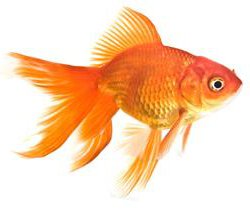Fantail Goldfish
Category: Gold Fish

Facts about Fantail Goldfish. The Temperament of the Fantail Goldfish is a Community fish. Family: Cyprinidae, Native To: China and Japan, Diet: Omnivore, Adult Size: 6" or more, Scientific Name: Carassius auratus, Expected Lifespan 10 years or more, Environment: Freshwater
The fantail goldfish dates back to over a thousand years from Japan and China. It is one of the oldest goldfish tat we know of, and it is one of the most popular goldfish.
The fantail goldfish is a western form of the Japanese version of the fantail, known as the Ryukin, which has a high dorsal fin, a shoulder that does not Fantail Goldfish are recognized by their medium sized double~split tail fins. You can tell the breeding quality of a Fantail goldfish by seeing how far their fins are split. The tailfin of a high quality Fantail goldfish is almost completely split down to the root. have the hump, an egg-shaped body, and a quadruple caudal fin. The fantail goldfish finnage is less developed than that of the Ryukin. The dorsal fin on the fantail gold fish is enlarged and accounts for approximately thirty three percent of the fish's body length.
This goldfish species is available in many colors ranging from orange to red and many colors in between.
The fantail goldfish can be kept in temperatures close to the freezing point. Fantail goldfish are best kept in cold water and a fantail goldfish aquarium tank or garden pond should be decorated with ample space for the fish to swim in as well as heavily planted areas. The bottom should be covered with a large grained substrate if you want to give any eggs that might be laid a small chance to survive with their parents. Plants that are suitable to be used in an aquarium with Fantail Goldfish. Pond plants and aquatic plants reference to plants for Fantail gold fish ponds on the internet, pet store or pond installers, to learn what are best for your set up. There is however a number of commonly available plants that are suitable to be kept in an aquarium tank with Fantail goldfish such as Elodea (Egeria),Crinum, and Anubias species. Java moss is another suitable plant to be used that also help give fry (new born fish) a chance to survive in your garden pond without help. You will have to protect the egg and fry from the parents or the parents will eat them if they get the chance. Some fry might survive and grow up in a well planted pond or aquarium. Large balls of java moss increase the chances for the young Fantail goldfish to avoid being eaten by other larger goldfish. Fantail goldfish should never be kept alone and always in groups. Fantail goldfish are also an good choice if you want to keep some type of fancy goldfish in garden ponds.
Fantail usually grow about 16 cm (6 inches) which is small in compared with other goldfish types such as comets goldfish that can reach over twice that length.
Fantail Goldfish eat most food sources and can be kept on a diet of flake food and pellets as long as you make sure that the food you use contains vegetables.
Fantail Goldfish is one of the easiest of the fancy goldfishes to breed. Make sure that you keep your gold fish well feed on a varied diet to get them in spawning condition. You will also need to lower the temperature in the pond or aquarium for a period of time to simulate seasons to get them to breed. Once the fishes have been kept in colder water for about a month or so you should slowly begin to raise the temperature and this process will trigger well feed, mature Fantail goldfish to spawn.

 Back To Category Gold Fish
Back To Category Gold Fish